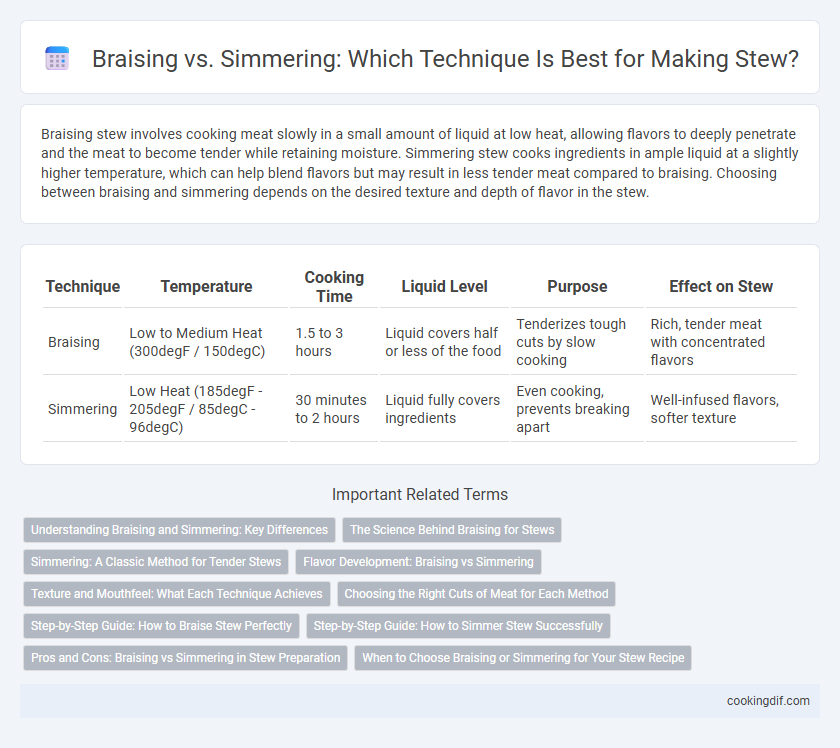Braising stew involves cooking meat slowly in a small amount of liquid at low heat, allowing flavors to deeply penetrate and the meat to become tender while retaining moisture. Simmering stew cooks ingredients in ample liquid at a slightly higher temperature, which can help blend flavors but may result in less tender meat compared to braising. Choosing between braising and simmering depends on the desired texture and depth of flavor in the stew.
Table of Comparison
| Technique | Temperature | Cooking Time | Liquid Level | Purpose | Effect on Stew |
|---|---|---|---|---|---|
| Braising | Low to Medium Heat (300degF / 150degC) | 1.5 to 3 hours | Liquid covers half or less of the food | Tenderizes tough cuts by slow cooking | Rich, tender meat with concentrated flavors |
| Simmering | Low Heat (185degF - 205degF / 85degC - 96degC) | 30 minutes to 2 hours | Liquid fully covers ingredients | Even cooking, prevents breaking apart | Well-infused flavors, softer texture |
Understanding Braising and Simmering: Key Differences
Braising involves cooking stew ingredients slowly in a small amount of liquid at low heat, allowing the meat to tenderize while infusing rich flavors. Simmering, by contrast, uses a larger quantity of liquid kept just below boiling point, which cooks ingredients evenly but may result in less intense flavor concentration. Understanding these techniques helps optimize texture and depth in stew preparation, with braising enhancing tenderness and simmering ensuring thorough cooking.
The Science Behind Braising for Stews
Braising for stews combines both dry and moist heat, using initial high heat to sear meat and lock in flavor, followed by slow cooking in liquid at low temperatures, which breaks down collagen into gelatin for a tender texture. This technique enhances the Maillard reaction, creating complex flavors, while the gentle simmering phase ensures even heat distribution and moisture absorption. The scientific balance of temperature and moisture in braising transforms tougher cuts of meat into rich, succulent stews.
Simmering: A Classic Method for Tender Stews
Simmering is a classic stew technique where ingredients cook gently in liquid at temperatures just below boiling, usually between 185degF and 205degF (85degC to 96degC). This method allows tough cuts of meat and root vegetables to become tender over extended cooking times, typically 2 to 4 hours, while flavors meld deeply. Maintaining a consistent simmer ensures even cooking and a rich, hearty stew texture without overcooking or breaking down ingredients.
Flavor Development: Braising vs Simmering
Braising enhances flavor development in stew by cooking meat slowly in a small amount of liquid, allowing collagen to break down and intensify rich, deep flavors. Simmering involves cooking ingredients fully submerged in liquid at a gentler heat, which softens flavors but may result in a lighter, less concentrated taste. The Maillard reaction during braising creates complex, savory notes that are less pronounced with simmering.
Texture and Mouthfeel: What Each Technique Achieves
Braising produces a tender, melt-in-your-mouth texture by slowly cooking tougher cuts of meat in a small amount of liquid, allowing collagen to break down into gelatin for a rich, silky mouthfeel. Simmering maintains a slightly firmer texture as ingredients cook in a larger volume of liquid at a gentle heat, preserving the integrity of vegetables and producing a lighter, brothier consistency. The choice between braising and simmering significantly impacts the stew's depth of flavor and overall tactile experience.
Choosing the Right Cuts of Meat for Each Method
Tougher cuts like chuck roast and short ribs are ideal for braising, as slow cooking with minimal liquid breaks down collagen, creating tender, flavorful stew. Simmering favors more tender cuts such as sirloin or stew beef, which cook faster and maintain texture without becoming mushy. Selecting the right meat cut based on the cooking technique enhances the stew's texture and richness.
Step-by-Step Guide: How to Braise Stew Perfectly
Start by searing stew meat in a hot pan to develop a rich, caramelized crust that enhances flavor. Add aromatics like onions and garlic, then pour in broth or wine to cover the ingredients halfway, maintaining a low simmer during cooking to break down tough fibers. Cover the pot tightly and cook the stew slowly in the oven at 325degF (160degC) for 2 to 3 hours until the meat becomes tender and the sauce thickens naturally.
Step-by-Step Guide: How to Simmer Stew Successfully
To simmer stew successfully, start by bringing the stew to a gentle boil before reducing the heat to maintain a low, steady simmer just below boiling point, around 185-205degF (85-96degC). Use a heavy-bottomed pot or Dutch oven to distribute heat evenly, and keep the lid partially covered to allow some steam to escape, preventing the stew from becoming too watery. Stir occasionally to avoid sticking, and simmer the stew for 1.5 to 3 hours, depending on the meat's toughness, ensuring tender, flavorful results without the caramelized crust typical of braising.
Pros and Cons: Braising vs Simmering in Stew Preparation
Braising stews involves cooking meat slowly in a small amount of liquid at low heat, which enhances flavor and results in tender, well-developed textures but requires longer cooking times and close temperature monitoring. Simmering uses more liquid and a consistent low heat to cook ingredients evenly, making it faster and simpler but sometimes causing less flavor concentration and potentially mushy vegetables. Choosing between braising and simmering depends on desired stew consistency, texture preferences, and time available for cooking.
When to Choose Braising or Simmering for Your Stew Recipe
Braising is ideal for tougher cuts of meat like beef chuck or pork shoulder, as it uses low heat and liquid to break down connective tissues over a longer cooking time, resulting in tender, flavorful stew. Simmering suits more delicate ingredients such as chicken or vegetables, cooking them gently in liquid to preserve texture and moisture without overcooking. Choosing braising enhances rich, hearty stews with deep flavors, while simmering is better for lighter, quicker recipes requiring precision in cooking temperature.
Braising vs simmering for stew technique Infographic

 cookingdif.com
cookingdif.com